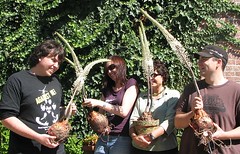by Tammara Hayimi Slilat
Like a pale ghostly finger,
a warning from down under,
the first blooming wand is sent
to sweep the cobwebs of complacency
from our sun blinded eyes.
And so, in the middle of summer's pleasure cruise,
while the sweet juice of a watermelon is trickling down our chin,
on our skin that has grown used to feeling free air,
the flower is drawn, pointed at our hearts and we remember
that indeed it has come out here last year as well.
 But in spite of our excellent memory
But in spite of our excellent memoryit always catches us off guard.
I was prompted to post this bit in response to the emerging shoots of my own Drimia maritimas, signaling the beginning of fall with their leafless shoots. The rosette of leaves died down months ago at the end of spring and the bulbs have lay dormant in their pot till now.
Years ago, during my tenure as a Head of the local Branch of The Mediterranean Garden Society, we received word from a fellow in San Jose, CA that he "had a lot of 'giant Mediterranean onions' he'd like to get rid of and would we please come get them?" From my home in Oakland, I contacted some of our members in the South Bay and we put out the word that these 'onions' were available for the taking. I asked someone in my area who was planning to go down and check this out to bring me bad one or two of these strange things.
Turns out the 'onions' were in fact Drimia [formerly Urginea] maritima, the Mediterranean Sea Squill. The bulbs were indeed quite huge!
 I can't imagine that he was eating these as this plant is a well known source (in the Mediterranean) of rat poison. We never did find out where he got these bulbs, but apparently they kept multiplying in the narrow space in which he'd planted them and he'd had enough of digging out the surplus.
I can't imagine that he was eating these as this plant is a well known source (in the Mediterranean) of rat poison. We never did find out where he got these bulbs, but apparently they kept multiplying in the narrow space in which he'd planted them and he'd had enough of digging out the surplus.How these bulbs divide is actually somewhat unusual - rather than producing basal offsets, these true bulbs split dichotomously (dividing or branching into two equal pieces). Each new bulb produced this way will flower in the next year or two, so a nicely blooming clump is had somewhat quickly.
The few bulbs I ended up with from the transaction mentioned above have multiplied enough to be able to give a few away and still have a number to plant in a large pot. These previously grew on the grounds around a local school, much to the delight of the children and their curious parents.
 When they suddenly needed to be dug (because of some maintenance about to take place over summer session) I was delayed in replanting them. In spite of bring out of the ground, they decided to flower anyway, inspiring an impromptu photo opportunity with my family. Like some other fall blooming bulbs, such as Amaryllis belladonna, this tendency to flower while out of the ground is not unusual - just be sure the bulb is planted before the leaves appear later.
When they suddenly needed to be dug (because of some maintenance about to take place over summer session) I was delayed in replanting them. In spite of bring out of the ground, they decided to flower anyway, inspiring an impromptu photo opportunity with my family. Like some other fall blooming bulbs, such as Amaryllis belladonna, this tendency to flower while out of the ground is not unusual - just be sure the bulb is planted before the leaves appear later.Here in California, a grower in the San Diego area now markets these bulbs for sale, so they are becoming far more common. Appropriately, they make a point of mentioning that these plants can grow without supplemental irrigation and are not bothered by deer or gophers.
A fall flowering plant is always of interest to me - after a mediterranean climate's long, dry summer dormancy, it is exciting to have cooler, wetter weather announced in such an pleasant way.
No comments:
Post a Comment